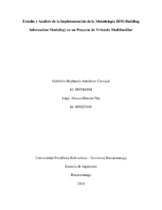| dc.contributor.advisor | Ramírez Velásquez, Jorge Mauricio | |
| dc.contributor.author | Antolínez Carvajal, Gabriela Stephanía | |
| dc.contributor.author | Rincón Pita, Jorge Alonso | |
| dc.coverage.temporal | 2018 | |
| dc.date.accessioned | 2020-05-29T14:16:21Z | |
| dc.date.available | 2020-05-29T14:16:21Z | |
| dc.date.issued | 2018 | |
| dc.identifier.uri | http://hdl.handle.net/20.500.11912/5492 | |
| dc.description | 112 páginas | spa |
| dc.description.abstract | En la ejecución de proyectos de construcción se debe tener presente como factor de gran importancia el cumplimiento del cronograma de los mismos, ya que se deben cumplir con fechas estipuladas para las actividades que los comprenden. Todo esto junto con los diseños y su interpretación son elementos indispensables a tener presentes y claros a la hora de planificar y ejecutar una obra de construcción. Debido a lo anterior, el uso de plataformas y herramientas de modelación de información (BIM) permite una realización de manera óptima y conjunta de esos diseños mediante simulaciones, para posteriormente en la ejecución de obra permitirles a los ingenieros una excelente interpretación de los mismos y con esto evitar problemas o inconvenientes que se puedan presentar. Se escogió un proyecto de vivienda multifamiliar en la parte estructural y de redes hidráulica y sanitaria, se realizó inicialmente un modelo 3D y posteriormente junto con el cronograma de actividades de esa obra se creó un modelo 4D que muestra una simulación de la ejecución de las mismas. Con lo anterior se busca estudiar y analizar la implementación del modelado de información (BIM) y también determinar causas de posibles diferencias y establecer ventajas y desventajas del uso del mismo. | spa |
| dc.description.abstract | In the implementation of construction projects should be present as a factor of great importance the fulfillment of the timetable for them, since they must meet the stipulated dates for the activities that comprise them. All this along with the designs and their interpretation are indispensable elements to be present and clear when it comes to planning and executing a construction site. Because of this, the use of platforms and modeling of information (BIM) tools allows a realization optimal and joint of those designs through simulations, to later in the execution of work allowed engineers a excellent interpretation of them and this avoid issues or problems that may occur. Was chosen a multifamily in the structural part and hydraulic and sanitary networks project, was initially a 3D model and then together with the schedule of activities of this work created a 4 d model that shows a simulation of the execution of the same. This seeks to study and analyze the implementation of modeling (BIM) information and also to determine causes of possible differences and establish advantages and disadvantages of the use of the same. | eng |
| dc.format.mimetype | application/pdf | |
| dc.language.iso | spa | |
| dc.publisher | Universidad Pontificia Bolivariana | spa |
| dc.rights | Attribution-NonCommercial-NoDerivatives 4.0 International | * |
| dc.rights.uri | http://creativecommons.org/licenses/by-nc-nd/4.0/ | * |
| dc.title | Estudio y Análisis de la Implementación de la Metodología BIM (Building Information Modeling) en un Proyecto de Vivienda Multifamiliar | spa |
| dc.type | Trabajo de grado | spa |
| dc.publisher.department | Escuela de Ingenierías | spa |
| dc.publisher.program | Ingeniería Civil | spa |
| dc.type.hasVersion | publishedVersion | spa |
| dc.description.sectional | Bucaramanga | spa |
| dc.description.degreename | Ingeniero Civil | spa |


